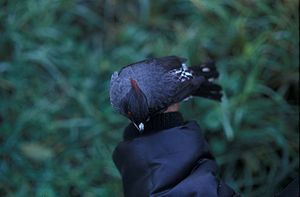Redhead kotinga
| Redhead kotinga | ||||||||||||
|---|---|---|---|---|---|---|---|---|---|---|---|---|

Redhead kotinga |
||||||||||||
| Systematics | ||||||||||||
|
||||||||||||
| Scientific name | ||||||||||||
| Ampelion rubrocristatus | ||||||||||||
| ( d'Orbigny & Lafresnaye , 1837) |
The Rotschopfkotinga ( Ampelion rubrocristatus ) or sometimes Rotschopfzuser is a species of bird from the family of ornamental birds (Cotingidae). This species has a large distribution area, which is limited to the countries of Bolivia , Peru , Ecuador , Colombia and Venezuela . The IUCN assesses the population as Least Concern .
features
The redhead kotinga reaches a body length of about 20.5 to 21 centimeters, with a weight of about 66 grams. It has red eyes and a small, light gray, thick bill with black spots that looks white in the field. The noticeably long, flat, dark, reddish-brown hood extends to the nape of the neck and is only straightened up in a state of excitement. The wings, tail, and a black stripe across her eyes are blackish. The feathers on the rump and cloaca are white dotted and the cloaca is additionally decorated with white borders. The whitish belly gradually turns gray towards the chest. The inner flags of the control springs have a large white band, which is particularly noticeable in flight.
The plumage of the top of young birds varies between a light olive and a warm brown tone and is traversed by wide dark stripes. This light olive to brown can also be found indistinctly on the crown, the rump and on the large and middle arm covers. The umbrella spring is outlined in white. The underside, which is also traversed by dark stripes, looks cinnamon to pale reddish brown.
distribution and habitat
They move mainly on the edges of undisturbed cloud forest , relatively open terrain, semi-humid forests and groves , especially when alder trees are present nearby . You can often see them in forest areas with Polylepis , Escalloniaceae and Bergaralien ( Oreopanax ). They live at altitudes between 2400 and 3700 meters. In Venezuela it is found in the Sierra de Perijá in the state of Zulia , in the Andes Táchiras near the mountains Páramo Cendé and Páramo Jabón . In Colombia they can be found practically on all three Andean mountain ranges, i. H. on the western, central and eastern Cordilleras. They are also present in Ecuador on both Andean chains. From Peru to Bolivia they can mostly only be found in the east. Only in northern Peru can you also find them on the slopes of the western Andes. In Bolivia the distribution area extends into the department of Cochabamba .
behavior
You can usually see redhead kotingas in pairs, but occasionally alone or in small family groups. In exceptional cases you can watch them with up to 10 conspecifics in a tree with fruit. They usually sit vertically in the trees and bushes so that they can easily climb up and down in search of berries (e.g. mistletoe berries). They often do not move for a long time, making them appear sluggish and almost tame. It is not uncommon to see them jump up briefly on the hunt for insects, only to land back on their ancestral place. If they meet a food rival, they put their forelock up at an angle and spread the tail upwards. They raise their voices in threat. Your wing beats sound rattling. Their throaty singing resembles the sounds of a frog and sounds like rreh or bababarre . Especially during conflicts, they emit a softer eh-eh-eh-eh . They build their nests from twigs and lichen, which they shape into a chalice.
Research history and etymology
D'Orbigny and Lafresnaye used the taxon Ampelis rubrocristata in their first description . Only later was the bird categorized in the genus Ampelion . The word Ampelion comes from the modern Greek word ampelouriós and means something like from the vineyards . The specific epithet rubrocristatus is derived from the Latin words ruber for red, rust-red and cristatus for comb-bearing .
literature
- Jon Fjeldså , Niels Krabbe : Birds of the High Andes: A Manual to the Birds of the Temperate Zone of the Andes and Patagonia, South America. Zoological Museum and Apollo Books, ISBN 978-8788757163 , pp. 445 f.
- Thomas Schulenberg , Douglas F. Stotz, Daniel F. Lane: Birds of Peru. Princeton University Press, 2007, ISBN 978-0-691-04915-1 , p. 488.
- Robert S. Ridgely , Paul J. Greenfield: Birds of Ecuador Field Guide. Volume 1, Cornell University Press, 2001, ISBN 978-0-8014-8720-0 , pp. 627.
- Robert S. Ridgely, Paul J. Greenfield: Birds of Ecuador Field Guide. Volume 2, Cornell University Press, 2001, ISBN 978-0-8014-8721-7 , pp. 541 f.
- Steven L. Hilty , John A. Gwynne, Guy Tudor : Birds of Venezuela. Princeton University Press, 2002, ISBN 978-0691092508 , pp. 649 f.
- Steven L. Hilty, William L. Brown: A Guide to the Birds of Colombia. Princeton University Press, 1986, ISBN 978-0691083728 , pp. 441 f ;.
Web links
- Ampelion rubrocristatus inthe IUCN Red List of Threatened Species 2011.2. Listed by: BirdLife International, 2009. Retrieved January 10, 2012.
- BirdLife International: Species Factsheet - Red-crested Cotinga ( Ampelion rubrocristatus ) . Retrieved January 10, 2012.
- Videos, photos and sound recordings of Red-crested Cotinga (Ampelion rubrocristatus) in the Internet Bird Collection
- Redhead kotinga ( Ampelion rubrocristatus ) at Avibase; Retrieved January 10, 2012.
- Ampelion rubrocristatus in the Integrated Taxonomic Information System (ITIS). Retrieved January 10, 2012.
- xeno-canto: Sound recordings - Red-crested Cotinga ( Apelion rubrocristatus )
- Antpitta Red-crested Cotinga Ampelion rubrocristatus image
- Flickriver red crested cotinga Ampelion rubrocristatus picture
- Flickr Red-crested Cotinga (Ampelion rubrocristatus) picture
- Flickr Ampelion rubrocristatus picture
- Flickr Ampelion rubrocristatus picture
- Mangoverde Red-crested Cotinga Ampelion rubrocristata image
- Mangoverde Red-crested Cotinga Ampelion rubrocristata image
- Mangoverde Red-crested Cotinga Ampelion rubrocristata image
